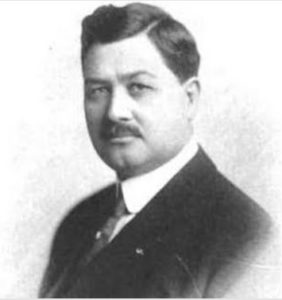
James T. Clyde, the manager of the new Hotel Lincoln at 700 Eighth Avenue, welcomed the stray kitten into his establishment and named him, appropriately, Abe.
“A half-grown cat has adopted the Hotel Lincoln as its permanent home. Cats have always been regarded as a good omen, especially when they come to the door unsolicited. This kitten has a special history. He was born on the site of the present hotel, and spent his life in the debris while the hotel was in course of construction. Let us all be kind to our new mascot. His name from now on is Abe.” — James T. Clyde, manager, Hotel Lincoln, March 1928
In Part I of this Old New York cat story, we met Abe, the lucky kitten who was born in the spring of 1927 on the corner of Eighth Avenue and 45th Street in New York City’s Time Square neighborhood. Although his mother cat and two brother kittens left the area a couple of months later, Abe stayed on the construction site. Even as the new Hotel Lincoln continued to rise higher and higher each day, Abe refused to scat.
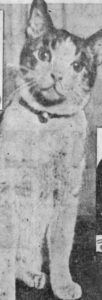
Abe in 1928
Life was good for Abe at the luxurious Hotel Lincoln. Not only was he adopted by a very prestigious hotel manager, but he also had a French chef who served his daily dish of meat, and a parlor maid who brought him fresh milk every day.
Abe loved all the attention he got, especially from the hotel guests. Any time a guest would remark, “Oh, what a beautiful cat!” Abe would shake the bell on his shiny red collar in appreciation. For those who made the effort to pet him, Abe rewarded them with a hearty purr.
Abe’s Hero, James T. Clyde
Abe owed his life to James T. Clyde, a prominent restaurateur and hotelier who loved animals, especially the horses and other animals that lived on his farm in Columbus, Ohio.
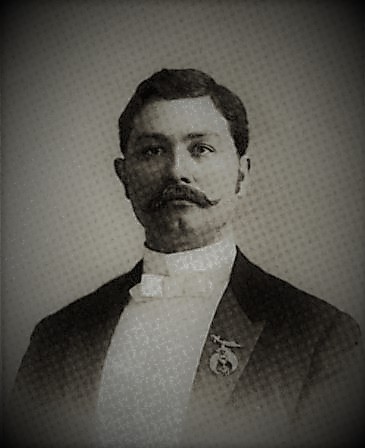
James T. Clyde
Born in Philadelphia sometime around 1863, James was an athletic man who excelled in boxing, swimming, and rowing at the University of Pittsburgh. During his early career he traveled extensively with carnivals and circuses in Australia, the United States, and Europe. He managed numerous hotels in New York, St. Paul, Boston, Cincinnati, Seattle, and Chicago, as well as several athletic clubs in Chicago, Columbus, and New York.
In January 1915, John Willy, writing in The Hotel Monthly, said this of Abe’s hero:
“Mr. Clyde is widely known as a caterer who has earned a reputation for rejuvenating hotels and clubs, changing them from losers to winners.”
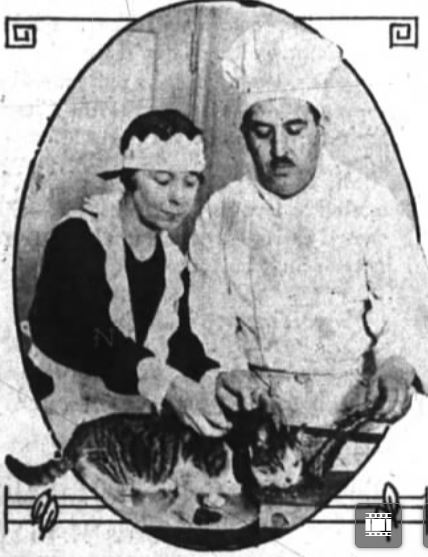
Abe with his best friends at the Hotel Lincoln.
By the time James Clyde was asked to manage the Hotel Lincoln in 1928, he was about 65 years old and ready for retirement. One year after Abe moved into the hotel, Clyde left the Hotel Lincoln and returned to his farm in Ohio.
I’m not sure if he took Abe with him, but I have a feeling Abe would have been too stubborn to leave his hotel life.
The End of the Hotel Lincoln
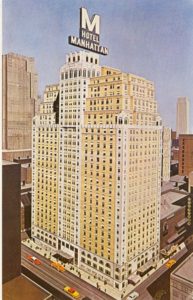
In 1958, the large Hotel Lincoln sign was replaced by a giant “M” for the Hotel Manhattan. The “M” was 31 feet wide and 12 feet deep, and was visible for 20 miles with 6,500 feet of neon tubing in colors that changed from white and gold to shades of blue.
In 1939, the Hotel Lincoln was sold to Mrs. Maria Kramer, a dancer and wife of Max J. Kramer, who owned the Hotel Edison on West 46th Street.
By this time, the hotel was under the management of Frank J. Kridel, who took over the Hotel Lincoln sometime around 1935.
The hotel continued to do well through the 1930s and 1940s, but less than 30 years after Abe the cat moved into the Hotel Lincoln, the once-grand hotel had become a rundown apartment hotel. No more French chefs or parlor maids or mascot cats; the hotel was now only a shell of its former self with empty, ghostly hallways (and I do mean ghostly, but that’s another story for another post.)
In 1956, developer William Zeckendorf got permission to evict the longtime rent-controlled tenants. These seven hold-out tenants put up quite a fight: Even when offered similar accommodations at the Knickerbocker on West 44th Street, they also refused to scat. It wasn’t until the residents were offered $3,000 each to promptly vacate did they leave their home.
The last to move out was Miss Edna King, a guest since 1929 who probably pet Abe the cat on many occasions.
In 1958, the Hotel Lincoln re-opened as the Hotel Manhattan. The hotel had a short stint as the Royal Manhattan when some English developers purchased it in 1964, but by then it was way past its prime. By the late 1970s, the hotel was all boarded up and left for dead.
In 1978, Paul and Seymour Milstein purchased the Royal Manhattan and renamed it the Milford Plaza. They reportedly gave it that name because they did not want to change the huge neon “M” on the roof.
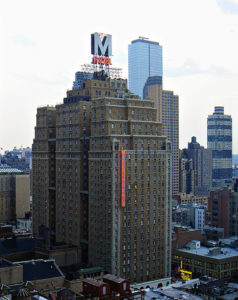
The Milford Plaza, sometime prior to October 2011, which is when the giant “M” was removed.
The Milstein family was ready to throw in the towel following the economic downturn in 2009, but a year later Rockpoint Group and hotel operator Highgate Holdings purchased the hotel for $200 million and began an extensive $140 million renovation.
As part of the renovations, the lobby and all 1,331 guest rooms and suites were updated. The neon “M” was removed one month after the World Trade Center attack, in October 2011.
In 2014, the hotel was renamed Row NYC. I often see the hotel sign when I’m walking down Eighth Avenue, and sometimes I pass it on my lunch-time walks. When I do, I stop and remember Abe the kitten, and try to imagine what it was like 200 years ago, when an English farmer named Medcef Eden grew onions and potatoes on this very spot.
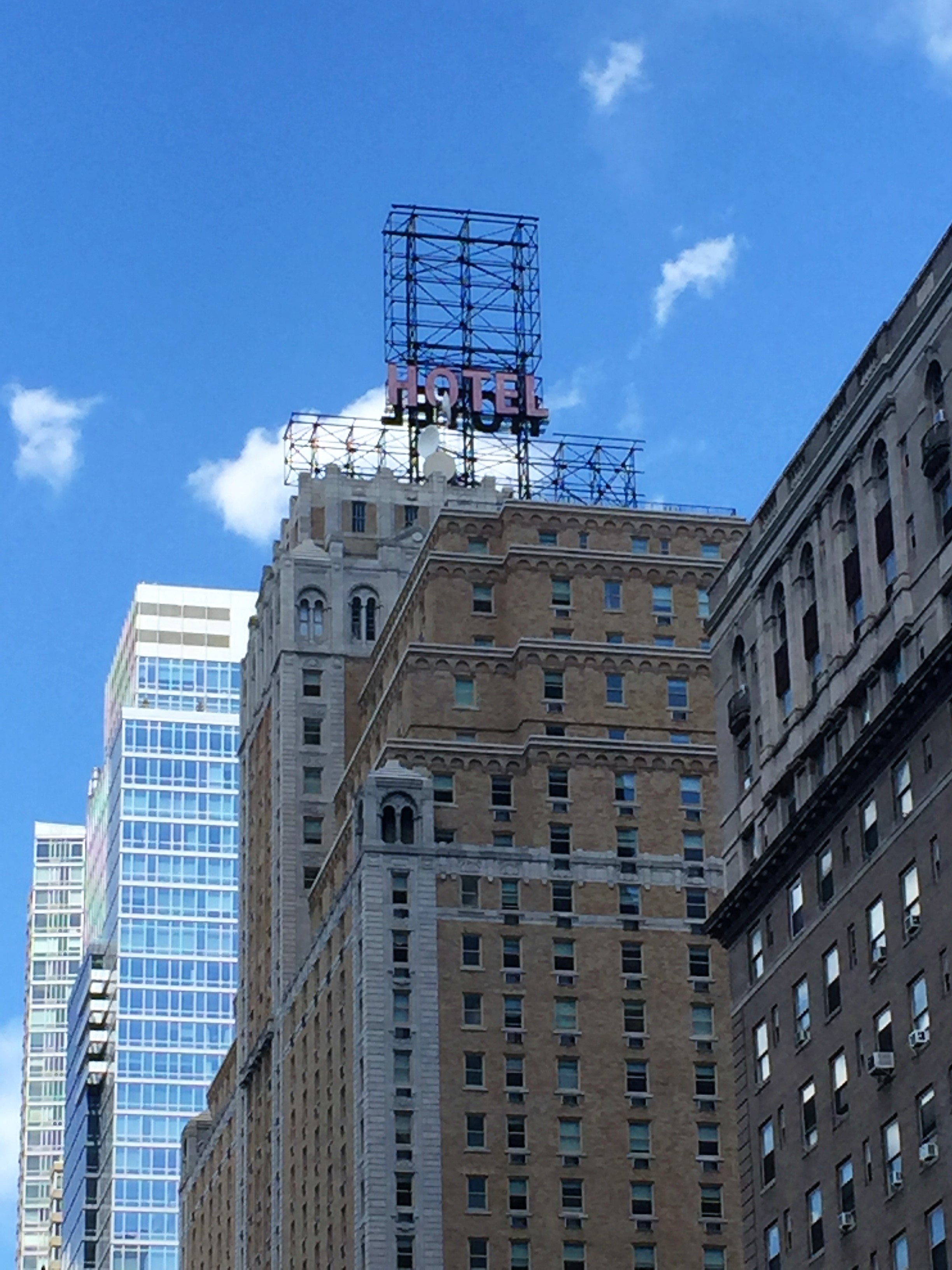
Now the giant “M” is gone, and the old Milford Plaza Hotel is dwarfed by many other buildings on Eighth Avenue.

The old Milford Plaza sign is still on the side of the old Hotel Lincoln building.
Sometimes when I walk past the old Milford Plaza Hotel I start to hum “the lullaby of Broadway…”
The Lullaby of Broadway
If you live in the New York metropolitan area, you probably recall the Milford Plaza commercial jingle from the 1980s and early 1990s. As I promised in Part I, I’ll now leave you singing the jingle.



